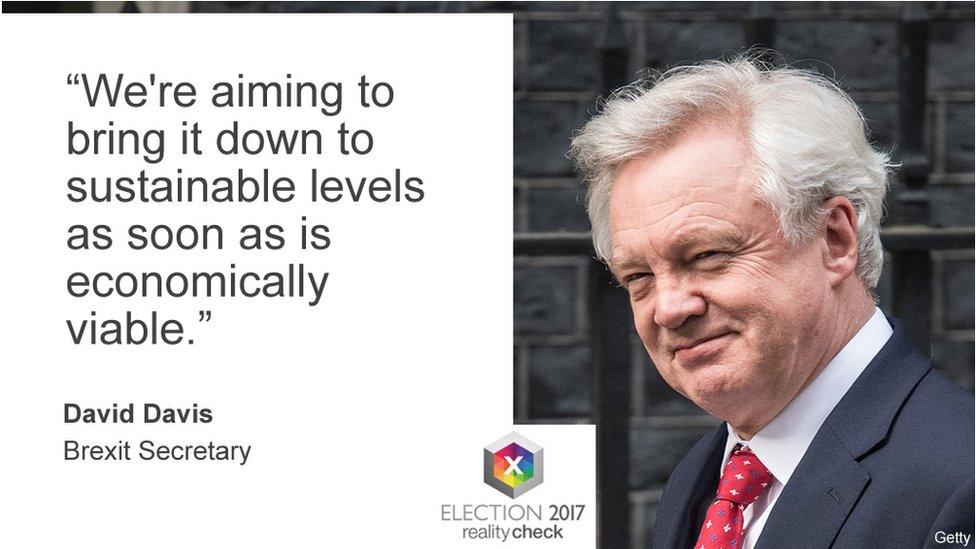Reality Check: Conservative manifesto on immigration
- Published

The claim: Brexit Secretary David Davis has said the Conservatives aim to bring immigration down to "sustainable levels as soon as is economically viable". In its manifesto, the Party repeated its commitment to reduce annual net migration to less than 100,000.
The verdict: There is simply not enough detail in the published proposals to predict their impact on non-EU migration. In terms of migration from the EU, the Conservatives plan to end freedom of movement, but they have yet to set out a policy to replace it.
Brexit Secretary David Davis has said the Conservative pledge to bring net migration down to the tens of thousands is a "major policy imperative".
It is a goal that has existed since the 2010 Conservative manifesto, but has never been met.
The most recent data shows that annual net migration to the UK is running at an estimated 273,000, so there is a long way to go.
Of those people, roughly half are European Union citizens and half are from non-EU countries.
When asked how long it would take to meet the objective, Mr Davis said: "We're aiming to bring it down to sustainable levels as soon as is economically viable. And the aim is to do it in a way that doesn't cause labour shortages, that allows us to train people up to do the jobs."
Non-EU migration
The Conservative manifesto contained a plan to double the Immigration Skills Charge, external to £2,000 a year by 2022.
The charge, introduced in April, is designed to encourage employers to train UK workers rather than employ overseas staff.
It affects workers seeking a Tier 2 work visa, which is for skilled workers earning more than £30,000 per year.
There is a cap of 20,700 Tier 2 visas available every year and some occupations, external are given priority to help fill skills shortages in the UK.
The government publishes a list of those priority occupations. It includes engineers, nurses and ballet dancers.
Some types of workers can avoid the cap altogether. For example, workers transferring within companies are not subject to that cap.
Overall, the number of Tier 2 visas was 56,058 in 2016.
Most of those visas are likely to attract the raised charge. That might be more manageable for larger employers, but for smaller companies it might be a more significant expense.
Funds from the higher charge will be used to train UK workers for those high priority sectors. That could mean more training in computers and information technology, as workers in those sectors take up half of the Tier 2 visas.
Non-EU families and students
The Conservatives plan to raise the earnings thresholds for those hoping to get visas for family members outside the European Union.
There was no detail on how much that will be increased. At the moment, those applying to bring a partner to live with them must have a minimum annual income of £18,600 before tax.
For applicants bringing dependent children, the threshold rises by £3,800 for one child and £2,400 for each additional child.
But it is hard to bear down too much on that area of immigration, as it affects some British nationals who want to bring family members from abroad and they have the right to do so.
Finally, visa requirements for students will be tougher and they will be expected to leave the country after their course is finished, unless they meet higher requirements for them to work in the UK. There was no detail about what those requirements might be.
But migration experts point out that the government has already cracked down in this area and reducing student numbers further would be difficult.
There is a question over whether students should be included in the figures at all. If they were to be excluded that would reduce the immigration figures by around 120,000 a year.
EU nationals
About half of migrants to the UK come from the European Union. Both the Conservatives and Labour plan to end their right to freedom of movement.
So the UK needs a new immigration policy to regulate those workers.
In their manifesto, the Conservatives pledged to "control" the number of migrants from the EU, "while still allowing us to attract the skilled workers our economy needs".
How much that will affect overall immigration depends on what sort of policy is in place. The government faces a major challenge in getting that legislation passed before Brexit in March 2019, so some kind of transitional period is likely.
The independent Office for Budget Responsibility has estimated that cutting annual net immigration from 273,000 now to 185,000 by 2021 - still a long way short of the below 100,000 target - could cost £5.9bn - because of considerations such as a lower tax take and a higher proportion of non-working people in the overall population.
On the BBC's Newsnight, the Defence Secretary, Michael Fallon, said the cost to the economy had not yet been worked out.


